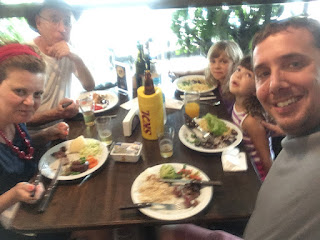Our third and last day in Foz do Iguaçu was much calmer than the last few days. We didn't need to rush out the house and Avi and I took a couple of hours in the morning to do some shopping downtown - which is a few blocks away from where we are staying. The main shopping street is Avenida Brazil (Brazil Ave), with many souvenirs and affordable clothes shops.
Our favourite store on the strip: a cheap jewellery story. Avi and I have a soft spot for different jewellery and even though we left with not too much, we were like kids in the candy story just looking at unique pieces.
Travelling with style.
I just love all the shapes and shades of green.
If you come to Brazil and don't go to a Churrascaria (barbecue house) at least once, you haven't really experienced the country and its culture - unless you are vegetarian. On our last day we tried a Rodízio de Carne, which is basically an all-you-can-eat huge buffet PLUS different meats being brought to your table every few minutes. You accept it or not. This churrascaria costs R$40 (CAN$17) per person, plus drinks.
Happy faces before starting a (much needed) strict diet back home... right away, please!
Right across from the churrascaria we visited the Bosque Guarani, a city run zoo, right across from the bus terminal. The place is beautiful, with big trees, nice shade, calming ponds and relaxing attraction. I am not sure, though, about the animals' well-being. I love seeing the different species, but zoos always make me sad too. The cages looked pretty small and old to me. The zoo is free.
Most of the animals are from this region: crocodiles, turtles, parrots, macaws, monkeys, quatis and one jaguar.
The area is beautiful, right in the heart of the city.
The biggest expectation for the girls was to see the jaguar. It was pretty impressive and majestic, indeed.
The day ended with a brief and wet tour to the Three Borders Landmark (Marco das Três Fronteiras).
SOURCE: WIKIPEDIA https://en.wikipedia.org/wiki/Triple_Frontier
The Triple Frontier is a tri-border area along the junction of Paraguay, Argentina, and Brazil, where the Iguazú and Paraná rivers converge. Near the confluence are the cities of Ciudad del Este (Paraguay); Puerto Iguazú (Argentina) and Foz do Iguaçu (Brazil). This area is near Iguazú Falls and the Itaipú hydroelectric plant.
We are standing in Brazil, right in front of Argentina and beside Paraguay.
SOURCE: https://www.visitefoz.com.br/en/attractions/three-borders-landmark/
The Three Borders Landmark was already one of the main historical points of the city of Foz do Iguaçu, where the Iguaçu and Paraná rivers meet, but more than that, three great South American nations are together: Argentina, Brazil and Paraguay. The landmark symbolizes a bit of the reality of the region, where the borders are so close and present that sometimes do not seem to exist.
The new tour, now with entrance ticket payment, is a different experience for tourists. The new constructions honor the Jesuit Missions, and all the visual and sound ambience of the tour directs the visitor’s focus to the history of the foaming of the region of Foz do Iguaçu, including a beautiful 12-minute projection on Cabeza de Vaca, the first white man to see the Iguaçu Falls in 1542 (which is often forgotten by the city itself) and on the political and social formation of the city.
Cabeza de Vaca was the first European to "find" the Iguazu Falls. This memorial tells a bit of his story, with a 12 minute documentary about his life and the missions in the region (in Portuguese).
SOURCE: https://en.wikipedia.org/wiki/Álvar_Núñez_Cabeza_de_Vaca
Álvar Núñez Cabeza de Vaca was a Spanish explorer of the New World, and one of four survivors of the 1527 Narváez expedition. During eight years of traveling across the US Southwest, he became a trader and faith healer to various Native American tribes before reconnecting with Spanish civilization in Mexico in 1536. After returning to Spain in 1537, he wrote an account, first published in 1542 as La relación y comentarios ("The Account and Commentaries"), which in later editions was retitled Naufragios ("Shipwrecks"). Cabeza de Vaca is sometimes considered a proto-anthropologist for his detailed accounts of the many tribes of American Indians that he encountered.
In 1540, Cabeza de Vaca was appointed adelantado of what is now Argentina, where he was governor and captain general of New Andalusia.] He worked to build up the population of Buenos Aires, where settlement had declined due to the poor administration. Cabeza de Vaca was transported to Spain for trial in 1545. Although his sentence was eventually commuted, he never returned to the Americas. He died in Seville.
Here are three counties: Argentina (top left), Brazil (bottom) and Paraguay (top right).
The Brazil landmark. From here it is possible to see the same obelisk in Argentina and in Paraguay in the colours of each country. I have a picture of myself standing right in front of this monument, at age 11, at home. Good memories, but back then there was no park, just the landmark.
From this important landmark for Latin America, I end this trip. Three days in Foz do Iguaçu was enough to get to know a bit of this beautiful town and its amazing natural attractions. Thanks for the hospitality and great memories.

















No comments:
Post a Comment